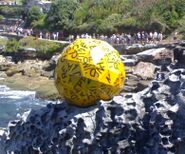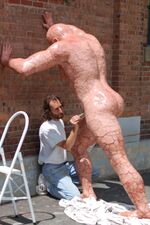Art
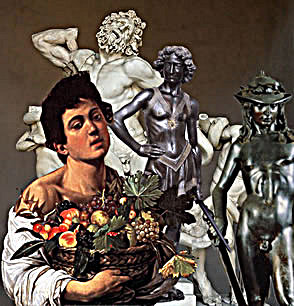
Art is defined as the production of bored, depressed and/or insane people with way too much apple sauce on their hands. It ranges from Picasso's cubist paintings, to Michelangelo's sculptures, to some dude banging on a container with a drumstick in one hand and a carrot in the other. The latter is a perfect example of Avant-Garde art. There are two groups of people (artists excluded) who actually appreciate art: People who enjoy art simply because they think it makes them better than you, him, her, it, them, and everybody else for that matter. Hippies, who are too open-minded to hate anything. Art critics are not included among these groups because they actually hate it, which is exactly why they became critics. Many artists, such as Vincent Van Gogh, have gained somewhat of a cult following, similar to Monty Python and William Shakespeare.
History[edit]

Humans created works of art long before written history began, which is bad news for people who have to study the history of art at school. The cave paintings at Lascaux and Astley, the mysterious obsidian sculptures of the Maya, and Joan Rivers' hairdo are all examples of prehistoric art. Art was invented entirely by accident by an unlucky Neanderthal who was carrying a piece of mammoth meat and tripped. The steak then hit the wall of the cave, and the blood spattered all over the place. The tribe elder was really impressed because some of the blood stains slightly resembled humans or animals, so he killed the man responsible to use his blood for painting. Blood has remained the single most popular red pigment used in art, human blood particularly favoured for its vividness. With the age of Enlightenment and the emergence of silly concepts such as human rights human paint has been substituted with animal varieties. However, over the past two decades Greenpeace activists have managed to re-introduce human blood as red paint, to protect endangered species.
There's no doubt that prehistoric man also practiced dance, music, and storytelling -- performance art. Archaeologists surmise that the beat generation of the late Neanderthal culture recited "poetry" to the accompaniment of bongos or drums made from the remains of their enemies or in-laws.
Having an over-active imagination was considered a great asset to being an artist in ancient days, however this was discouraged during the Renaissance when people without imagination were jealous of the fame the artists were receiving. This gave birth to Realism. With the emergence of Expressionism and Modern Art, imagination was again encouraged. The artists without any compensated by ingesting copious amounts of hallucinogens and smoking pot.
"The Flow of Consciousness"[edit]
This form of Literature, first invented in 1492 by Christopher Columbus, involves 'ingesting hallucinogens'. This results in mental voyages, and usually manifests in so-called "Poetry", but in recent times it has also manifested as those weird movies with no apparent plot, digital art, and most prominently Psychedelic Rock.
What makes humans create art?[edit]
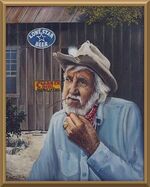
Is it the desire to have something nice to look at instead of the same old crap they've got lying around the house? Is it an attempt to infuse meaning, substance, and spiritual nourishment into their lives? Or is it just an idle pastime, slightly more interesting than watching the hands of their clocks move?
Dr. Stan Bulowski, head of research of the Social Anthropology department of the University of Borborygmi, Canada has suggested that art fulfills a deep and spiritual need within the male human to have long hair, smoke joints, wear crumpled clothes, not bathe for three months, never shave, and still have the ability to pick up hot girls by harping on constantly about their being a "tortured and sensitive soul".
Other experts in this field have suggested that it is simply easier than getting a real job.
Inspiration[edit]
Inspiration is the first step to creating art. It is generally followed by Expiration, which can be the actual creation process, or death, depending on the artist's situation. As a rule, artists never actually have inspiration to create art, which results in very forced works, which results in artists actually creating rubbish. The literary equivalent of lack of inspiration is called writer's block not to be confused with writer's cock, an entirely different thing.
The Seven Deadly Arts[edit]
- Graphic Arts include painting, biromash, etching and sketching and retching, Photoshopping, batik, and the like. In the most fundamental sense these art forms are something you look at, like internet porn or the signals at a pedestrian crossing.
- Sculpture, for our purposes, includes such shaped creations as bas-relief, papíer mache, plastic surgery, jello molds, bronze castings, etc.
- Music is, basically, noise. Sometimes the noise is rhythmic, sometimes harmonious, but often it is neither. Singers may or may not perform music, and they may or may not be accompanied by such instruments as sackbutts or bazookas. It's wide-open, baby. The artsiest forms of music that currently exist include Classical music, Avant-Garde, Jazz and Progressive Rock.
- Literature includes the written artforms: poetry, prose fiction, plays (in written form), comic books, and Readers Digest™. Prose can be defined as "words-in-a-line" while poetry is "words-not-in-a-line" and Readers Digest is goat kidneys wrapped in a paper cover.
- Performance art has expanded from the traditional concepts of Shakespearan or Greek plays performed on a stage to include the performances of street mimes, acrobatic cat-hurlers, monologists, and polylogists. Seminal works of performance art include Antonio Glebovich's "Faeces in a Bucket" and Catherine Shumley's master work "Wales" which consisted of the artist strutting naked around a shopping mall in Southern England shouting "I'm a Rhonda valley commando!!" for 17 hours.
- Video art is typified by the television show Wheel of Fortune and the classic of video expression "Bung-ho Babes XI". It is not a play, it is not poetry, it is neither dance nor music. Video art dates to the vellum flip-movies of the middle Renaissance.
The Minor Arts[edit]
- Culinary art creates FAT things which are pleasing, or not pleasing but interesting, or neither pleasing nor interesting but, nevertheless, must be art because they are not FAT for anything else.
- Fashion art seeks to create interesting clothes. In general this artform runs in circles, with nothing new under the sun. I mean, come on, there are only so many ways to wrap a piece of cloth around a skinny model.
- Forming words by belching is an artform practiced mostly by FAT boys and certain thick-necked beer aficionados in Alabama and Mississippi.
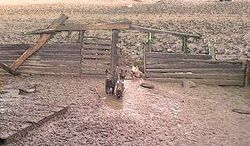
- Landscaping creates arrangements of plants, rocks, mounds, and water features. Golf courses are one example; Zen gardens another. Some landscape artists use animals like hogs to create poignant and depressing commentaries on the human condition.
- Perfumery creates interesting scents. Jackson Haddock's monumental perfume "Squid Docks Of Hokkaido" evokes the Japanese Fisherman's Rebellion of 1552, when 30 tonnes of squid rotted on the docks of Nemuro. The impact of this great work is unmistakable and the aroma does not leave your clothes for weeks.
- Rolling bombers can be quite an art, though the aftermath may leave participants dazed and confused, and with terrific munchies.
- Internet comic writing is not really the same as other Literary Arts. Like carving methane and making bubbles in the bathtub, it is evanescent and often smells like rotting cabbage.
- Miner Art is often confused with Minor Art. Miner Art is a form of sculpture practised underground, in the dark by Miners and???? that's all we know, as nobody has ever seen any of it. (That's due to the darkness, stupid. Now stop asking awkward questions; this is art and it doesn't need to make sense, in fact, it's better if it doesn't make sense).
- Exploding Arts is quickly becoming one of the more popular forms of art. All you need is some dynamite a target to destroy. That single moment of explosion completely tops every other form of art out there! Terrorists are the undisputed masters of this art.
- Armpit Farting Is an artform from ancient Celtic society which has enjoyed something of a revival in recent years. "Pitfarts" involve the creation of sounds similar to anal flatulence by creating a small area of suction under the armpit with a cupped hand and moving the adjacent arm up and down to create the "tune". Armpit farting also has the distinction of being simultaneously an artform, a recognised sport in the 2008 Olympics and the absolutely funniest thing you can do during a forensic psychology lecture by an eminent but boring visiting professor.
- Penguin Art utilises penguins or penguinoid creatures such as footballers, which are then dressed up in dinner suits and fed to leopard seals or killer whales, symbolising the futility of life and/or the creativity of fish.
- The Programming Arts takes seemingly normal humans and turns them into crazy people who spend their lives intertwined within their while() loops and classes. It is believed that programming is a form of self mutilation that is considered an art form, simply because of the complex confusion and stress it causes. The art of programming is the number one cause of anurisms worldwide.
Wonders of the World[edit]
See also[edit]
- Abstract Art
- Artist
- Artistic License
- Auto-destructive art
- Baby Impressionism
- Boredom
- Dadaism
- Doodling
- First Gradeism
- Graffiti
- In MS Paint With One Arm, While Furiously Masturbating
- King Arthur
- Laziness
- Look It's Art
- Post-postmodernism
- Art Snob
- Still life
- The Swimming Hole
- Welsh Love-fork


